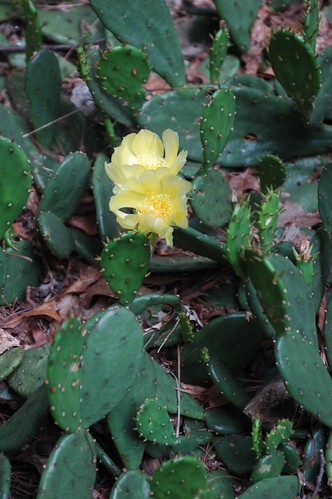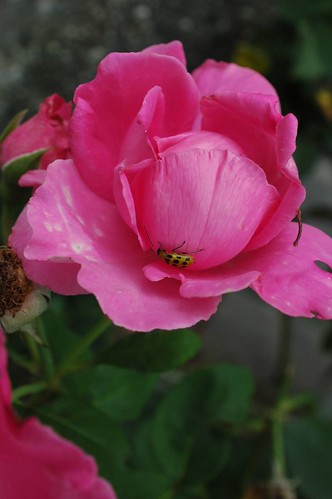
Photo of the planting area and several containers and benches at Garden
#2 in Park Slope. The view is roughly east-northeast. Note the fences marking the edges of the property, the trellis against the rear fence, the diagonal path leading to it, and the concrete in the foreground. The planting area from the concrete to the fences is only 10′ deep and about 15′ wide. Most of its edge is hidden by plants and containers. You can see the edge of the first stepping stone on the path to the trellis.
Visible in bloom are, left to right,
Corydalis lutea (low yellow mounds),
Allium (tall purple/pink “space balls”), hybrid
Aquilegia (yellow and red), and
Iris siberica (deep blue/purple). If you view the full image you can also see the blooms of chives in the strawberry jar, hardy
Geranium in front of the tall
Allium, and
Centaurea montana, to the right of the trough. There are at least two other flowers blooming visible in the photo, but I’m not sure what they were.
Photo taken: May 26, 2002. The garden is 10 years old in this picture. This is one of the last photos I took of this garden before I moved to Garden
#3, also in Park Slope, with my partner.
In 1992, I moved to Park Slope, Brooklyn from the East Village, Manhattan.
How much to say about that move? It was neither easy, nor smooth, for me. For many reasons, it was more about abandoning myself, leaving unhealthy things behind, than feeling that I was moving toward anything new. To really let go, to allow my true self to emerge, I had to leave empty space in me and around me. I could not continue living where I was.
I knew it was important that I have some kind of outdoor space in which to garden, even just a patio. At first, I looked for a new apartment in the East Village. But I couldn’t find anything I could afford on my own, and I had lived alone long enough to know I wasn’t ready to try to share with anyone. Though I rarely travelled out of Manhattan, I decided to start looking in Brooklyn, specifically in Park Slope because I had heard it was a gay-friendly neighborhood (it is).
It was difficult to leave the East Village garden behind. After ten years gardening there, it had become a luxuriant and peaceful oasis. I had learned about the qualities of light and shade, how the shadows fall at different times of the year, the importance of selecting plants by form and foliage before flowers, the rhythms of life in a garden. Though everyone who lived in the building enjoyed it, I knew there was noone who lived there who cared about the garden, or understood it, as I did. My ex-lover had moved out of the city years before. I would have to walk away, knowing that I had created something beautiful, and hoping that someday someone would take my place as its caretaker.
I came to be the first tenant of a young couple who had just bought a brownstone in Park Slope. (Actually, we’re all about the same age; we were all so young then!) My apartment was the ground floor of the building, the garden apartment, with the entrance under the front stairs. Out the back door of the bedroom was a small, attached room, and beyond that, the backyard.
My landlords later told me that one of the things which sold them on me was my response to that outside attached room. Everyone else who saw the apartment suggested “I guess you could use this for storage?” When I saw it, I exclaimed “A potting shed!”
The backyard was at first intimidating. It was an unbroken expanse of battleship-gray concrete extending the width and back to all but the last ten feet of the property. There, on the only exposed ground, were placed (I would not say “planted”) five shrubberies: a juniper, a pine, and five azaleas which bloomed, one week out of the year, a seering magenta. Amidst these was distributed a mulch of pine bark the size of dinner plates.
This tabula rasa was a chance to start another garden from scratch. It had more sun and light than the shady East Village garden, even full sun during the summer. I could grow things I had only dreamed of growing: daylilies, Iris, Allium, and more. There were new challenges, lessons to learn, skills to acquire.
I learned how to garden in containers. I learned what “drought-tolerant” and “constant moisture” really mean. I learned how to make and recycle potting mixes in bulk, cheaply and efficiently. I learned that cedar is not signifcantly more “rot-resistant” than pine when in constant contact with soil, and figured out how to reinforce and preserve wooden containers to get a few more years out of them.
I learned to cope with, adapt to, and celebrate the ecstatic chaos of children in the garden. There was, of course, the idyllic sharing in the beauty of flowers, leaves, and insects. There was also the competing needs of two active boys playing basketball and fragile, ill-placed pottery. The basketball won on more than one occasion. I learned to garden defensively. And there was the afternoon the younger watched me plant and label a shipment of plants. It was not until I was almost done that I realized that, while I had continued, he had carefully removed all the labels from the plants and placed them back. He grasped the significance of what I was doing and emulated me. He had not yet learned to read. The plants gew and thrived, anyway, however anonymously.
I lived and gardened there for ten years until 2002, when my partner and I moved in together at another apartment in Park Slope.

A closer view of the planting area taken two years earlier. The diagonal path is not yet overgrown. In the foreground are some of the afore-mentioned broken pots, used here as decoration along the brick edge.
Photo taken: May 27, 2000

A tableau of plants in five different containers. The container on the left is a cedar planter; the red-leaved plant spilling out of it is a
Heuchera. In the foreground is a plain old terracotta “azalea” (3/4 height) pot planed with herbs: sage, rosemary and thyme, I think. Behind that is a hand-thrown
Guy Wolff pot planted with a zonal geranium (
Pelargonium). The container on the right is a teak planter I had just finished planting; a poppy and a pale-flowered violet are blooming in it. Behind them all
Hemerocallis “Hyperion” spills out of a wooden tub planter, hidden in shadow.
I built the teak planter from a kit from
Wood Classics, an employee-owned business in Gardiner, New York. The slats are loose; they still have popsicle sticks beween them to maintain even spacing when the container was filled with soil.
Photo taken: July 4, 2001











